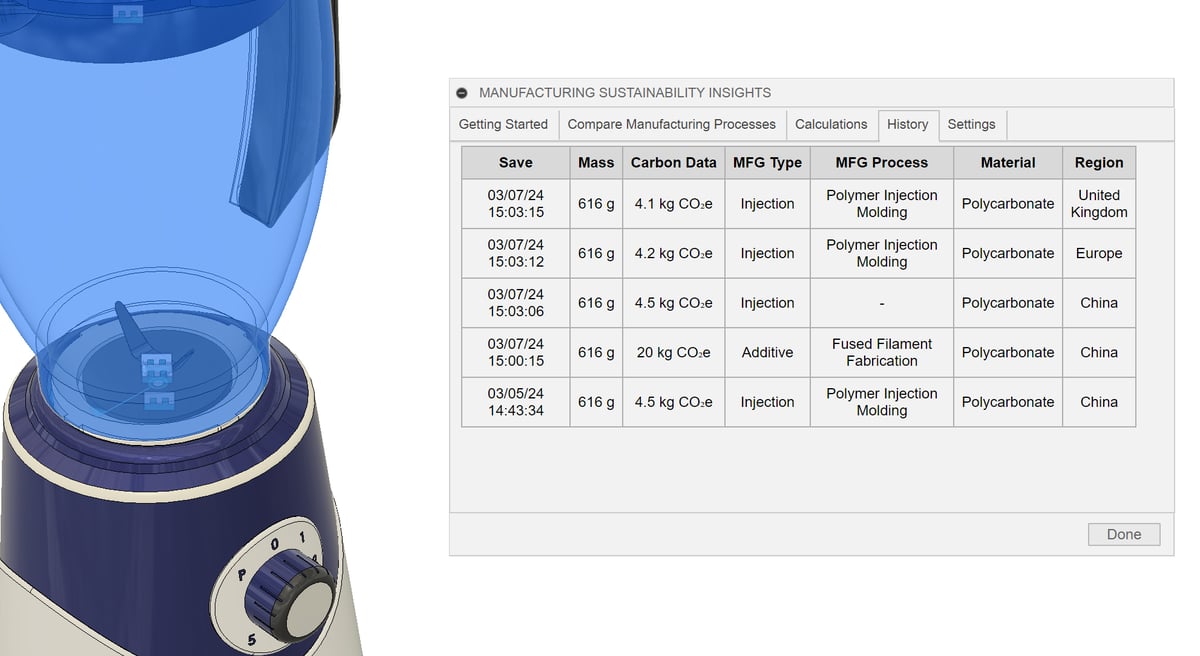How do you go about designing a “greener” product? Reduce the amount of plastic? Enable it to run on less electricity? Manufacture it with 3D printing?
Consumers and industries want more sustainable products (and more sustainable versions of existing products), but that’s easier said than done from a design perspective. There are so many possible green options that also have to balance with functionality, cost, and manufacturability.
Nearly all (four-fifths) of a product’s lifetime carbon emissions are determined by decisions made during the design stage, according to a report by McKinsey & Company.
So now, software giant Autodesk aims to enable easier and earlier sustainable design decision-making with a new, free add-on to its computer-aided design (CAD) program Fusion.

Called the Manufacturing Sustainability Insights (MSI), this tool will help you uncover the carbon impacts of each design decision, so you can make better, more informed decisions about sustainability.
“With just a few clicks, users can calculate the carbon emissions of their designs and identify alternatives to reduce the product’s carbon footprint,” says Autodesk. “This could include anything from emissions associated with the extraction, processing, location, and transportation of a chosen material to the manufacturing process.”
MSI, developed in partnership with Gravity, a decarbonization platform for industrial applications, integrates carbon data directly within Fusion. The tool provides real-time visibility into the carbon impact of design and manufacturing variables, from material selection to manufacturing process and even geography.
These early insights in the design phase can not only help your company reduce embodied carbon in its products, but also back up its claims of offering a more sustainable product.
“With the growth of consumer demand for greener products and increasing regulations, now is the time for organizations to embed sustainability into their process and deliver what the customer really want,” says Zoe Bezpalko, Autodesk’s senior design & manufacturing sustainability manager.
How does MSI work?
MSI is quickly downloadable from Autodesk here and it even works with the free, consumer version of Fusion for both Mac and PC.
You can evaluate the sustainability of your design at at stage, but for demonstration purposes, Autodesk provided this blender.
You can select any part of the blender to analyze and compare manufacturing types (injection molding, various additive manufacturing, milling, etc.), materials, and specify the manufacturing location, like China or Sweden.
Using the “Compare Manufacturing Process” feature, you then identify the key contributors to your design’s emissions. Different manufacturing processes have varying concentrations of emissions.
For example, while additive manufacturing is energy intensive, it also boasts high material efficiency, according to Autodesk. You can also weigh the decisions of designing parts for the blender with minimal mass, all while identifying manufacturing in a country with a cleaner grid mix (i.e., how energy is produced in a country.) The visibility of a country reliant on green energy sources versus more polluting energy, such as coal, is now transparent without the need for any additional data or research.
With the “Calculations” feature, you can understand the data used for the analysis, how carbon values are computed, and explore external documentation with further details on these calculations.
MSI also tracks all changes and monitors your design modifications. The “Persistent View” feature continuously tracks emissions during the design process and supports multi-component analyses. Designers can use this tool for live feedback from MSI on how their design changes are impacting the carbon value of their product.
Take it for a test drive here.
License: The text of "Autodesk’s Free Fusion Add-On Calculates the Sustainability of Your Design as You Design It" by All3DP Pro is licensed under a Creative Commons Attribution 4.0 International License.

